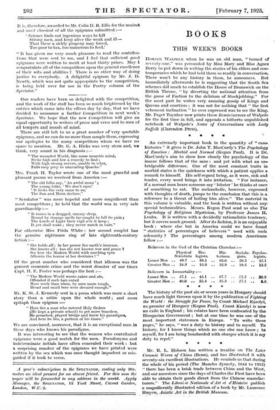An extremely important book in the quantity of "case. histories"
it gives is Dr. John T. MacCurdy's The Psychology of Emotion : Morbid and Normal (Kegan Paul). It is Dr. MacCurdy's aim to show how closely the psychology of the insane follows that of the sane : and yet with what an us- bridgeable difference. One of the most constant traits in morbid states is the quickness with which a patient applies a remark to himself. His self-regard being, as it were, sick and tender, every word brings it into irritation. "For instance, if a normal man hears someone say' lobster' he thinks at once of something to eat. The melancholic, however, engrossed with thoughts of death, jumps to the conclusion that this is a, reference to a threat of boiling him alive." The material in, this volume is valuable, and the book is written without anyl special technicalities. Messrs. Kegan Paul send us also The Psychology of Religious Mysticism, by Professor James H. Leuba. It is written with a decidedly rationalistic tendency, but it covers much ground. After its fashion, it is an enjoyable book : where else but in America could we have found "statistics of percentages of believers" used with such solemnity ? The percentages among modern Americans follow :— Believers in the God of the Christian Churches :—
Physical Scientists
Bio- logists. His- torians.
Sociolo- Psycho-i gists. logists.
Lesser Men .. 49.7 .. 39.1 .. 63.0 .. 29.2 .. 32.1 Greater Men., 34.8 .. 16.9 .. 32.9 .. 19.2 .. 13.2 Believers in Immortality :-
Lesser Men .. 57.1 .. 45.1 67.7 .. 52.2 26.9
Greater Men .. 40.0 ..
25.4 35.3 .. 27.1
. 8.81










































 Previous page
Previous page